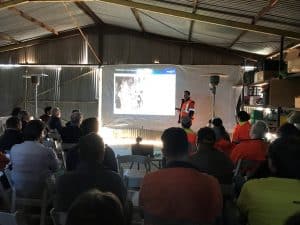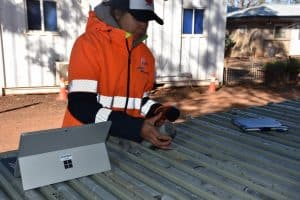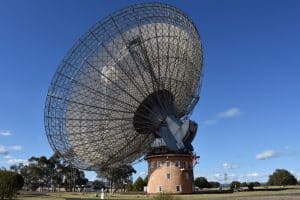Geobank Product Strategy Manager Mark Gabbitus recounts his recent trip to country NSW for Peel Mining’s Conversations and Core event.
Peel Mining recently added Geobank Mobile and Geobank to their existing Micromine licences for use at their exciting NSW prospect. Mark Gabbitus (Geobank Product Strategy Manager) was invited to site for a day of “Conversations and Core” with about 30 other Geologists from around the country.
The plan was to meet at the Wilkerboon Station (Peel’s base camp), spend some time looking at their recent drill core and then listen to some presentations before a few beers and a chance to chat about Geology, life and everything else.
Driving to site from Dubbo is a 4 ½ hour trek through dry (the drought is bad out here) farmland and into the bush. There were hundreds of Kangaroos around, so you have to be wary and there was a lot of roadkill by the side of the road to remind you if you forgot.
Wilkerboon Station is a short dirt road drive off the main Kidman Highway and is where the Peel exploration team is based. After a quick induction to the site we gathered round the core trays laid out on racks in the yard and listened to the exploration Geologists discuss the local Geology and explain what they have been finding in recent drillholes. The Cobar basin is host to several Copper and Gold operations, but it is a difficult place to find a new deposit because the ore is often hosted in unremarkable oceanic Turbidites. Some of the core laid out had some amazing looking intercepts, full of sulphides that are sure to assay well.

The Geologists from other local companies and Geological Surveys were very interested in what they had found and there were some great discussions on what the rocks were, ages and ore genesis theories. After a few hours of this we were ushered into the old station shed where chairs and a make shift projector screen had been set up for presentations.

First up was Adam McKinnon who is the Geological Superintendent at Aurelia Metals, Hera mine. Hera was the last, big deposit found in the Cobar basin and has been successfully mining underground for several years. The discovery story of Hera was particularly interesting as there was a 20-year gap between the deposit being drilled and YTC finding the mine. One of the original exploration holes, 20 odd years ago was stopped just 20m from the main ore body which shows you how easy it is to miss an orebody in this region.
Following Adam was Joel Fitzherbert who is a Senior Geologist with the Geological Survey of NSW. Joel is studying the age of rocks and orebodies in the Cobar basin and the implications it has for ore genesis in the region. Finally, we had an excellent presentation from Ross Cayley who is a Senior Geologist at the Geological Survey in Victoria.
Ross has been studying and mapping the Geology of Victoria for years and has developed a new theory for some of the unexplained features we see in Victoria, NSW and as far as Alice Springs which was very exciting.
Essentially no one has been able to fully explain the Geology of Victoria and why it is why it is. Lots of theories have been proposed over the years but none of them fully explain what you can see when you look at the rocks. Ross’s theory showed how by using the Geology and Geophysics together it could be explained. Essentially around 400 million years ago there was a subduction zone along the Eastern edge of what is now Australia (much like the one along the Western edge of South America today). The oceanic plate was subducting under the continental plate as normal until a micro-continent (Tasmania) came along and messed everything up. This caused bending of the subduction zone and all of the strange features we now see in Victoria and NSW. If proven true through further studies this will be the first time we have really understood the Geology of Eastern Australia!
This talk created quite a buzz and after Ross had finished we all moved to the fire pit (it was starting to get very cold) to have a few beers and chat about what we had learned that day. As the sun dropped so did the temperature so we were all grateful for the big fire the Peel team had built up for us. A few more beers and some steak really capped off a great day.

Wilkerboon Station doesn’t have rooms for 30 visitors, so it was time to get out the swag and bed down for the night. Temperatures were expected to drop below zero during the night, so everyone got rugged up in their sleeping bags and bedded down for the night as best they can. Before going to bed I took a stroll away from camp and all man-made lights to have a look at the stars. Seeing the Milky Way on a clear winters night out in the bush never gets old and with Mars, Saturn and Jupiter all bright in the sky it was a great finish to the day.
Waking up cold the next morning we gathered round the fire for a breakfast of bacon rolls before most people left for a tour of the Hera mine. My mission was to spend a few hours with the Peel Geology team showing them how Geobank Mobile works and learning how they do things. The great thing about Geobank Mobile is that it is so easily configurable and after a short while they were excited to see that their current workflow (with some improvements) would easily fit into the package. Of particular interest to them was the integration between Geobank Mobile and Micromine that they could do on their field devices. Peel Mining’s head office is in Perth and they often have to wait days to see their drillholes in 3D in Micromine which is usually too late to correct any issues such as hole deviation. With the easy, near real-time, integration between the products the Geologists can enter as-drilled data into Geobank Mobile and see it updated in Micromine at the rig. Hopefully this could prevent a hole being stopped 20m away from the main orebody like at Hera.

It was then time to drive back to Dubbo and head home. For the return journey I decided to go a slightly longer route via Parkes as I have always wanted to see the Radio Telescope there (The Dish). Driving along a quiet country road I saw something small moving across the road and slowed down to see an Echidna. Echidna are relatively rarely seen, and it was my first wild one, so I stopped and took some photos, to say I was a bit excited is an understatement.

After that I was smiling all the way to Parkes and the smile only got wider as I got my first glimpse of The Dish from the road. The scale of it is immense but it’s the connection it has to the Apollo 11 mission that makes it such an Aussie icon. If you haven’t seen the movie then I highly recommend it, in fact I watched it again on the plane back to Perth.

Peel have got a very exciting find over in NSW and whilst they are super busy it was great that they found time to host so many people, I had a great time.








